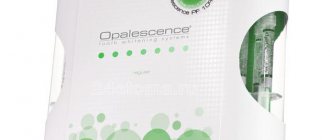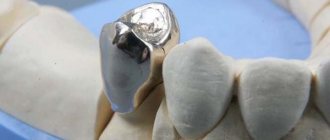Is it possible to whiten metal-ceramic crowns?
Unfortunately, it is impossible to achieve perfect whitening of fillings and metal-ceramic crowns. So, for example, modern dental ceramics is a fairly dense and hard material, so the brightening compounds used today have practically no effect on it.
The photo shows a metal-ceramic crown
But if the restored areas and prosthetic structures are located in the posterior parts of the jaw, the front teeth can be whitened. Then the difference in shades will not be noticeable. Otherwise, it will not be possible to achieve uniform whitening and an aesthetically pleasing smile. To do this, you will have to look for other solutions to the problem.
Why is it impossible to lighten ceramics?
The ceramic coating is fired in the dental laboratory. After this it becomes super strong. It is impossible to influence it with bleaching gels and solutions. Bleaching mixtures will not penetrate the ceramic coating, so lightening will not occur. This property is typical for all types of orthopedic structures.
Teeth whitening should be done only before dentures. After the procedure, the dentist will select future crowns based on the color of the lightened enamel. This means that at the end of treatment, your smile will be flawless.
It is impossible to whiten teeth made of metal ceramics. The only caveat: if they are not in the smile line, then whitening is possible in the front area. Chewing teeth are not noticeable when speaking, therefore, no one will see the difference in the color of the front and chewing teeth.
How to paint metal ceramics
One of the options for lightening fillings and crowns is to stain them. For this purpose, various compositions are used today: liquid enamel, professional dental paints and varnishes. Recently, Dental Paint has gained particular popularity. One of its main advantages is that it allows you to paint even hard-to-reach places, and also successfully solves the problem of darkening of filling materials, crowns and dentures. With its help, you can achieve lightening of up to 10 tones, and at the same time the result will look natural1.
Dental Paint can be used to lighten teeth
However, this method also has one significant drawback - the effect will be short-lived, so the procedure will soon have to be repeated. This method is similar to applying makeup, because the paint will be washed off after the first brushing of your teeth. Yes, and you cannot use such products on an ongoing basis, since this can lead to the destruction of the filling or crown. The materials from which they are made do not absorb paint, so it is impossible to change their color in this way. In such cases, dental experts recommend timely replacement of restorative materials and prostheses.
Is it possible to whiten ceramic crowns and veneers, and what whitening methods does dentistry offer?
Dentures made of ceramics or metal-ceramics do not always satisfy the patient with their quality, since the materials can darken over time and be stained by food, drinks, and tobacco smoke. Either the crown or veneer was initially made darker than desired. A logical question arises: is it possible to whiten ceramic teeth? The answer is not always clear, but there is always a solution to the problem. Read more about this in today's article.
Ultrasonic cleaning and its effectiveness
You can restore the natural whiteness of your smile and lighten artificial crowns a little using the procedure of Prof. hygiene. The method involves cleaning teeth from plaque and deposits, and today various technologies are used for this purpose, including an ultrasonic scaler. This is a hardware technique that involves delivering ultrasonic waves and microvibrations through a special tip, which literally break hardened deposits into tiny particles. At the same time, a jet of water is supplied, which removes dirt and also protects the enamel surface from overheating.
As part of comprehensive hygiene, ultrasonic or laser cleaning is usually combined with sandblasting of enamel using an Air-Flow device. This is a mandatory preventive procedure that should be performed every six months. But here it is worth noting that it will not help whiten either fillings or crowns. Lightening occurs only by removing plaque and deposits.
The photo shows the method of brushing teeth with the Air Flow system.
What methods of whitening are there in dentistry?
Before we figure out how to whiten ceramic[1] teeth, let’s first look at what whitening methods exist. So, the methods by which you can whiten living enamel are essentially of two types:
- abrasive (mechanical): small and hard particles of the whitening agent scrape off plaque and pigmentation from the surface of the teeth. The clinic uses the Air-Flow hardware method for this, when a mixture of air, drops of water and fine powder is applied to the patient’s teeth under pressure. At home, pastes with a high abrasiveness index (RDA more than 100) are used. It is impossible to whiten stubborn stains, just as it is impossible to make teeth lighter than their natural shade,
- chemical: it whitens the enamel from the outside and a little from the inside - it depends on how deeply the bleaching agent penetrates. The whitening gel contains hydrogen peroxide and/or carbamide peroxide. Using this technique, you can lighten your teeth by 8-12 shades in a clinic and by 2-3 shades at home.
The chemical technique, in turn, can be supplemented by activating the whitening gel with a special lamp - LED, ultraviolet, laser. These are the most effective methods, because... they provide 10-12 shades of whitening.
Why is it better to do whitening after filling, but before prosthetics?
If you want to undergo a whitening procedure, but also have a filling, you still need to take care of your dental health first. For example, professional in-office whitening is carried out only after removing plaque and deposits, installing fillings or replacing them. You should immediately discuss your plans with your doctor and select the material of the desired shade.
As for prosthetics with crowns, this procedure can be carried out after bleaching. This will make it easier to choose a ceramic shade that exactly matches the current enamel color.
Can dentures be whitened?
Can ceramic teeth be whitened? Imagine ordinary dishes made of ceramics and glass - these compositions are inert to chemical bleaches, peroxide, vinegar and other acids, and alkalis. After all, even in laboratories, aggressive chemicals are stored in such containers - and the shade of their walls does not change.
Thus, ceramic veneers, crowns, restoration inlays, and bridges cannot be whitened using chemical methods. Or just lighten the surface darkening a little - and then while it is “fresh”. Those. until the dyes and plaque have eaten into the microscopic pores and cracks on the surface of the ceramic. Abrasive pastes will also only remove surface deposits, and can only harm the prosthesis itself - if solid particles scratch the top coating, it will lose its aesthetics even faster.
Veneers as one of the options for solving the problem
Returning to the question of how to whiten metal-ceramic teeth, it must be repeated that the paints and varnishes existing on the market today cannot ensure long-lasting results, so patients have to look for other alternative solutions to the problem. For example, you can install veneers - thin snow-white overlays that are fixed on the front surface of the teeth using a special adhesive composition, thereby masking any minor defects, including chips, pigmentation, slight curvature and crevices.
Veneers can help change the color of teeth
Modern veneers are created from durable ceramics or glass ceramics, which are quite resistant to mechanical stress and are not subject to staining. However, before installing them, the teeth have to be ground down, and they will not return to their original state.
“I had a large filling on my front tooth since my youth, when I was involved in professional sports. Naturally, over time it became gray, and this was very noticeable. At some point I simply stopped smiling and complexes appeared. That's why I decided to get veneers. The doctor recommended E.max, it is glass ceramic, it looks beautiful and natural. It’s already been three years since I installed it, nothing has chipped anywhere, as they scared me. So I'm very pleased."
Nika11.91, from correspondence on the forum www.32top.ru
Therefore, an even better option is Lumineers. These are very thin and at the same time durable plates, the installation of which does not require preliminary preparation of the enamel. In both cases, it is first necessary to take impressions of the patient’s teeth, and microprostheses will be created based on them. There is also the option of installing veneers using the direct method - in this case, the doctor will cover the teeth with a layer of composite. However, there are some nuances here. For example, the material can also fade over time and is typically inferior in strength and durability to veneers created from impressions in a laboratory.
Is teeth whitening harmful?
Very often our patients ask whether teeth whitening is harmful. It's actually safe. We use modern systems where the active gel composition is not dangerous for a limited exposure time.
When you go to a real clinic and see an experienced doctor, you don’t need to be afraid of anything. We do not recommend smile whitening in salons where the procedure is performed by personnel without dental training.
Different professional teeth whitening systems require the use of gel of different concentrations. During the consultation, the doctor will determine the condition of your enamel and choose the optimal concentration that will not cause severe sensitivity after the procedure.
Is it possible to whiten teeth at home?
To maintain the natural whiteness of your teeth, it is important to brush them twice a day with a properly selected brush and toothpaste, rinse your mouth after every meal, use floss and antibacterial rinses, give up cigarettes and coffee, and undergo a professional procedure. hygiene every six months.
But if you naturally have a slightly yellowish or grayish tint to your enamel, even following all of the above measures will not be able to ensure an impeccably white smile. To do this you will have to resort to bleaching. This can be done at home in several ways:
- pencil - brightening gel is produced in a special tube, at the end of which there is usually a soft brush, brush or sponge for convenient application of the composition to the enamel surface. You must use the whitening pencil strictly according to the instructions. Typically, the gel is applied twice in the morning and evening for 2 weeks.
- strips and aligners - the gel can be immediately applied to the strips, which should be glued to the outside of the teeth for a certain time. Other systems include special mouth guards. Their inner surface must be independently coated with a lightening composition and then put on the dentition,
- abrasive pastes - they usually contain coarse abrasive particles, due to which the whitening effect is achieved. However, you cannot use them on an ongoing basis, otherwise you can damage the enamel, which will lead to its weakening and increased sensitivity - the development of hyperesthesia.
When whitening at home, a tray with a special gel is often used.
Before trying any of the methods described above, you should definitely consult a doctor. The specialist will conduct a visual inspection and determine the current condition of the enamel, and give his recommendations on choosing the appropriate system. If the enamel is weakened, thinned or too sensitive, the use of whitening strips and abrasive pastes is strictly contraindicated.
The only alternative
If you have metal-ceramic structures that do not suit you in color, the only right solution is to replace them. Metal ceramics have a certain service life. Over time, the ceramic surface can wear off and chip, which affects aesthetics.
At our dentistry in Moscow, orthopedists install highly aesthetic dentures that will not only create a snow-white smile, but also reliably protect teeth from external influences.
Ceramic crowns on a zirconium dioxide frame are the best prosthetic option in all respects. These designs combine the strength of zirconium dioxide and the high aesthetics of a ceramic coating. A perfect, precise fit to the gum, the high light transmittance of these crowns creates an unrivaled smile. The cost of such prosthetics is high, but the result justifies the cost.
During your consultation, orthopedic dentists at our clinic will tell you in detail about all the features of these structures, give you an idea of the cost and the number of visits needed to create a snow-white smile.
Principles of caring for metal-ceramic crowns
To prevent darkening of fillings and crowns, it is important to provide competent and systematic oral care. As mentioned above, basic hygiene rules include regular brushing of teeth twice in the morning and evening, rinsing after each meal, as well as visiting the dentist for prevention and cleaning of dental plaque at least once every six months.
If you have a bridge in your mouth with metal-ceramic crowns, it is important not to forget to clean the rinsing channel located between the gum and the structure. An irrigator is ideal for these purposes. Experts in the field of prosthetics also provide the following recommendations regarding the care of metal ceramics:
- try to avoid temperature changes in food and drinks, due to which the porosity of the material increases and it turns yellow,
- If possible, avoid coffee and strong black tea, since these drinks quickly lead to staining,
- You should not gnaw hard foods with your teeth or crack the shells of nuts and seeds.
An irrigator is an additional device for maintaining oral hygiene.
To keep your teeth healthy and your smile snow-white, you need to pay enough attention to caring for and maintaining hygiene. Modern fillings are made from high-quality materials that cannot be stained for a long time. The same can be said about modern dental ceramics, which are distinguished by their durability, high aesthetics and color fastness. Therefore, with proper care, the material will not darken and will retain its aesthetic properties throughout its entire service life.
1According to data at the office. manufacturer's website: dentalpaint.ru.
How to preserve the color of artificial teeth?
Prosthetic structures retain their color and texture for a long time only with careful care and handling. To maintain aesthetic characteristics you should:
- Clean dentures after all meals. Each time you need to thoroughly rinse the structures under running water.
- Do not use whitening toothpastes with abrasive particles for cleaning. Under their influence, scratches are formed on the surface, which subsequently accumulate plaque.
- Use special products for cleaning and disinfection once a week. Most often they are sold in the form of tablets that dissolve in water.
- Avoid drinking colored drinks and foods. Coffee, tea, colored juices and berries can leave stains on dentures.
- Avoid strong changes in temperature in the oral cavity. They can lead to loosening of the construction material and darkening of its color.
- Stop smoking. Nicotine worsens the color of not only natural teeth, but also dentures.
If it is not possible to return the original color of artificial teeth, it is better to take the removable module to the clinic for professional cleaning. There the original appearance of the structure will be quickly restored. Or at least they will remove plaque and stains that the patient could not cope with on his own.
How to whiten darkened teeth if you have crowns and other dentures
If, while wearing ceramic dentures, your teeth become darkened by plaque or tobacco, you can whiten them. To do this, the dentist will select the optimal method for the patient, based on the condition of the teeth - whether they are healthy, whether they have cracks or fillings. Whitening methods in the clinic and at home have already been discussed above. But if, for example, only the old filling has darkened, then it is worth replacing it - putting a new one in the desired shade.
Read on the topic: artistic restoration with a filling - how to make your smile more attractive in 1 visit to the clinic.
You can also cover your natural teeth with veneers or crowns (if they are severely damaged) in a color that perfectly matches the shade of the crowns, bridges or veneers already in your mouth.
What to do if ceramic dentures are darkened by plaque
How to whiten ceramic teeth that have become darker due to bacterial plaque? It has already been noted that it is impossible to bleach ceramics. But you can make it lighter with the help of dental procedures - for example, by removing tartar and plaque using professional oral hygiene. It is carried out by dentists - a therapist and a hygienist. The stone is very carefully removed from teeth and dentures using an ultrasonic scaler and hand instruments - it is important that the ultrasonic waves do not disturb the fixation of the orthopedic structure.
And plaque is removed with gentle air-abrasive Air-Flow (“Air-Flow”). Next, doctors use a professional paste for cleaning, and at the end of the procedure they perform polishing. An additional bonus of professional hygiene is that your own enamel becomes 1-2 tones lighter.
Hygiene features
Products made of metal ceramics do not require any special care, as they are durable, their surface is so smooth that they do not accumulate plaque. Care for metal-ceramic teeth must be organized in the same way as for natural teeth, the main thing is to do it regularly and efficiently.
You can clean metal-ceramic teeth with a regular brush.
Metal ceramics do not require a special diet, but you should not test its strength (opening bottles with your teeth, gnawing bones, etc.). Due to such experiments, the ceramic layer may chip, after which the prosthesis will have to be repaired or replaced.
It is also necessary to remember that there is a living tooth under the crown. It is important to prevent food from getting under the crown. Yes, this is possible even with modern technologies that make it possible to produce dentures that fit perfectly to the ground tooth and gum.
Expert opinion. Dentist at the Doctor-RAF clinic. : “The gums are very pliable, so when chewing food, pieces of it can easily push away the mucous membrane and get stuck between the gum and the denture. Over time, inflammation, swelling, and soreness will occur. For this reason, a small distance is specially left between the gum and the crown - a rinsing space. This gap allows the usual rinsing to clear out food that is stuck there.”
How to protect yourself from problems with dentures
In order for new teeth to maintain an attractive appearance for a long time and not cause other problems, you must initially carefully approach the choice of a clinic and an orthopedic dentist. It is advisable if dentistry has its own dental laboratory, where modern and high-quality ceramic materials are used. For example, ceramics, glass ceramics, fluorapatite, zirconium dioxide from Ivoclar Vivadent (IPS E.Max), Prettau, Kuraray Noritake, VITA Zahnfabrik. And the specialists were trained by material manufacturers, i.e. know how to handle them correctly.
Another important step is that before prosthetics, professional cleaning with ultrasound and Air-Flo is required, and sometimes professional whitening. After all, if your enamel is covered with plaque, then it looks darker than its natural shade - that is, the prosthesis will be made the same color. And then the patient wants to whiten his teeth or even just have his teeth professionally cleaned - as a result, the crown or veneer will turn out to be darker than the rest of the row. Therefore, do not neglect professional cleaning BEFORE prosthetics - a good dentist himself will offer to undergo it, because... understands all the risks.











